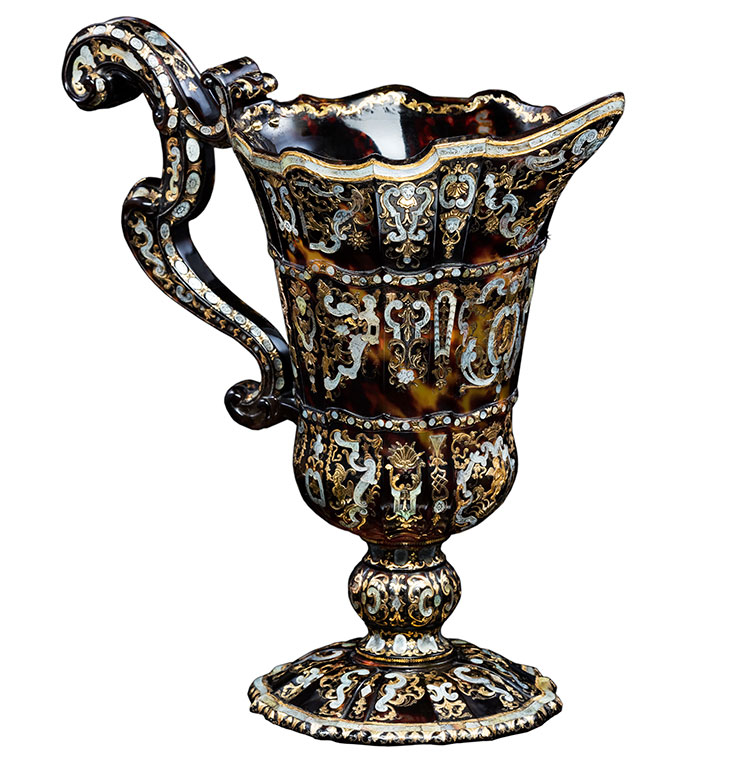‘We think this exhibition is going to prove a real discovery for most visitors,’ says Alexis Kugel of Galerie J. Kugel, of the Paris-based gallery’s forthcoming show, ‘Complètement Piqué: Gold, Tortoiseshell and Mother-of-Pearl at the court of Naples’ (12 September–8 December). ‘There are not so many of these objects in museums around the world, and we believe this technique to be one of the most beautiful practised in the 18th century. Certainly it is hard to find any works of art of comparable quality.’
This is believed to be the first show devoted to the art of piqué, a technique which found its apogee in Naples between around 1720 and 1760. The combining of precious materials was not in itself an innovation: forms of the practice can be traced to antiquity, while both mother-of-pearl and metalwork were widely used in marquetry from the Renaissance onwards, and tortoiseshell veneers from the 17th century. But it appears to have been the Neapolitans who alighted on the happy idea of combining not two but three of these costly materials to forge an array of luxury items of exceptional virtuosity.
Lidded goblet with monkey playing the flute (detail; c. 1730–40), attrib. to Giuseppe Sarao. © Galerie J. Kugel

It was these artisans – known as tartarugari (tortoiseshell workers) – who perfected the techniques of joining and moulding the shells of the hawksbill sea turtle into extravagant forms using boiling water and olive oil, and then impressing gold and mother-of-pearl into the softened shells. The appeal of these objects in part derives from the way in which the materials respond to light – the tortoiseshell becomes translucent, the mother-of-pearl iridescent and the gold sparkling – as well as the whimsical, often chinoiserie or singerie motifs of their decoration, drawn from the pattern books of Jean Berain, Paul Decker and Martin Engelbrecht.
The Hermitage table (c. 1730–40), Giuseppe Sarao. © Galerie J. Kugel

The centrepiece of the exhibition is an exceptional table, which is on loan from the Hermitage Museum in St Petersburg and is the masterwork of perhaps the greatest tartarugaro of them all: Giuseppe Sarao. Inhabiting the elaborate arabesques and cartouches of the tabletop alone are more than 100 chinoiserie figures, as well as countless playful monkeys, birds, dragons and the like, executed using a variety of techniques. Bearing arms of the Spanish Hapsburgs, it is a signed piece, as are a coffer, an ewer and a platter in the sale exhibition (two from the collection of Baron Henri de Rothschild). Added to this are some 27 further pieces that Kugel has attributed to the master – from snuffboxes and candlesticks to an inkstand, tabletop and a toilet mirror.
Working to identify these objects, Kugel copied and cut out hundreds of details of examples illustrated in books and auction catalogues, placing the cut-outs on the floor and pairing up motifs. ‘As I progressed, patterns started taking shape and it was possible to clearly identify the productions of different workshops,’ he explains. Among the 50 exhibits here, several are attributed to Tomaso Tagliaferro, including a 12-piece cutlery set in gilt silver and tortoiseshell, and even more to Gennaro Sarao, who is believed to be have been Giuseppe’s son.
Elaborately shaped ewer with pelmet motifs (c. 1735–34), Giuseppe Sarao. © Galerie J. Kugel

The show has been a decade in the making, and is the latest in a sequence of gallery exhibitions focusing on a field of fine or decorative arts that has been little studied and is deemed to be underestimated. An accompanying, generously illustrated publication – in French (Monelle Hayot) and English (Rizzoli) – adds much to the pioneering scholarship of Geoffrey de Bellaigue and Alvar González-Palacios, not least on the piqué objects presented as diplomatic gifts by Charles de Bourbon, king of Naples, to the Ottoman sultan Mahmud I. Included are chapters on materials and techniques, typologies and iconographic sources, as well as on the various workshops of the tartarugari magnifici. It concludes with a chapter on the great collectors of piqué – of whom Alexis Kugel and his brother Nicolas no doubt hope to find the next generation. Prices range from €10,000 to over €1m.
‘Complètement Piqué: Gold Tortoiseshell and Mother-of-Pearl at the court of Naples’ is at Galerie J. Kugel, Paris from 12 September–8 December.



